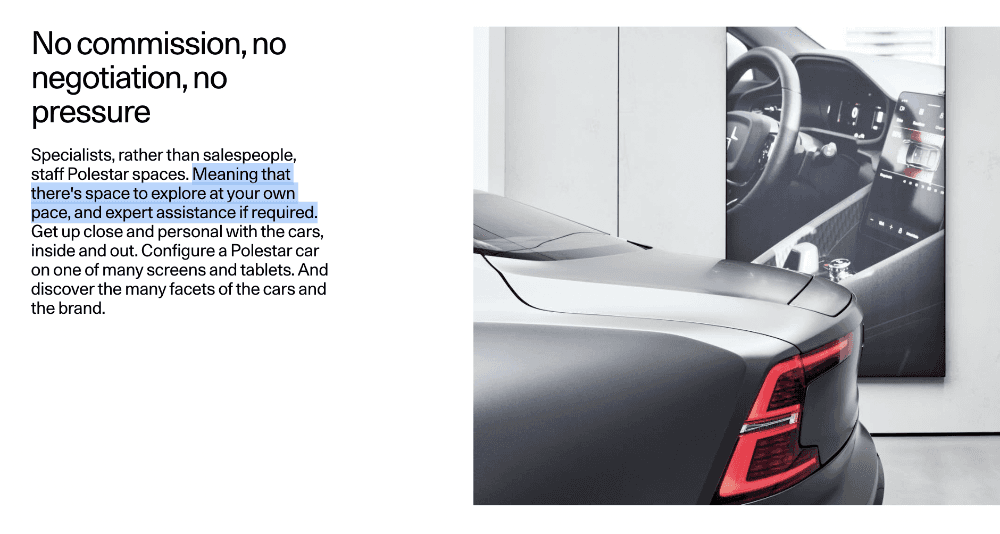


Nov 17, 2022
Nov 17, 2022
Growing electric car brands à la Tesla
Growing electric car brands à la Tesla

Written by
Written by
Aurelija Vyčaitė
Aurelija Vyčaitė
Dtc Radar
For every three leads, Tesla closes one deal. That’s a lead-to-order conversion rate of 33%, a percentage other car manufacturers can only dream of. Is it product quality? Great marketing? Definitely. Yet, Tesla’s successful conversion rate also has a lot to do with their seamless omnichannel experience. From a very early stage, Tesla stepped away from dealership networks and connected to their customers themselves. This direct-to-consumer (DTC) approach pays off and slowly but surely, other car manufacturers are following in their footsteps. What do they need to get to a successful DTC strategy? And what can digital commerce professionals learn from this story?
Let’s zoom into the biggest transformation in the car industry since, well, Tesla.
For every three leads, Tesla closes one deal. That’s a lead-to-order conversion rate of 33%, a percentage other car manufacturers can only dream of. Is it product quality? Great marketing? Definitely. Yet, Tesla’s successful conversion rate also has a lot to do with their seamless omnichannel experience. From a very early stage, Tesla stepped away from dealership networks and connected to their customers themselves. This direct-to-consumer (DTC) approach pays off and slowly but surely, other car manufacturers are following in their footsteps. What do they need to get to a successful DTC strategy? And what can digital commerce professionals learn from this story?
Let’s zoom into the biggest transformation in the car industry since, well, Tesla.
The Tesla experience
The Tesla experience
Historically, buying a car is a pain. For buyers, it’s a headache due to industrial model specifications, cumbersome financing, and endless paperwork. Car manufacturers, in turn, struggle with the dealership model where they cannot connect with customers directly and also lose a lot of margins to the middlemen.
But then there was Tesla. Elon Musk’s company let go of the dealer model and started selling directly to their consumers. To do this right, they built a seamless omnichannel experience that makes buying a car easy, fun and less complex. By aligning their offline and online strategy, the “Tesla experience” is the same across all sales channels. To make this happen, Tesla heavily relied on online interfaces, digitised point of sales, and self-service tools, like the vehicle configurator. Today, the DTC and omnichannel approach is the signature of Tesla’s brand and saves a lot of time for both customers and sales personnel.
Ultimately, Tesla’s pioneering approach resulted in:
33% higher lead-to-order conversion in certain markets*;
5 hours less time invested per car sold;
and 1.6x lower costs per car sold.
* Compared to one in ten at traditional automakers
Historically, buying a car is a pain. For buyers, it’s a headache due to industrial model specifications, cumbersome financing, and endless paperwork. Car manufacturers, in turn, struggle with the dealership model where they cannot connect with customers directly and also lose a lot of margins to the middlemen.
But then there was Tesla. Elon Musk’s company let go of the dealer model and started selling directly to their consumers. To do this right, they built a seamless omnichannel experience that makes buying a car easy, fun and less complex. By aligning their offline and online strategy, the “Tesla experience” is the same across all sales channels. To make this happen, Tesla heavily relied on online interfaces, digitised point of sales, and self-service tools, like the vehicle configurator. Today, the DTC and omnichannel approach is the signature of Tesla’s brand and saves a lot of time for both customers and sales personnel.
Ultimately, Tesla’s pioneering approach resulted in:
33% higher lead-to-order conversion in certain markets*;
5 hours less time invested per car sold;
and 1.6x lower costs per car sold.
* Compared to one in ten at traditional automakers
Historically, buying a car is a pain. For buyers, it’s a headache due to industrial model specifications, cumbersome financing, and endless paperwork. Car manufacturers, in turn, struggle with the dealership model where they cannot connect with customers directly and also lose a lot of margins to the middlemen.
But then there was Tesla. Elon Musk’s company let go of the dealer model and started selling directly to their consumers. To do this right, they built a seamless omnichannel experience that makes buying a car easy, fun and less complex. By aligning their offline and online strategy, the “Tesla experience” is the same across all sales channels. To make this happen, Tesla heavily relied on online interfaces, digitised point of sales, and self-service tools, like the vehicle configurator. Today, the DTC and omnichannel approach is the signature of Tesla’s brand and saves a lot of time for both customers and sales personnel.
Ultimately, Tesla’s pioneering approach resulted in:
33% higher lead-to-order conversion in certain markets*;
5 hours less time invested per car sold;
and 1.6x lower costs per car sold.
* Compared to one in ten at traditional automakers
Historically, buying a car is a pain. For buyers, it’s a headache due to industrial model specifications, cumbersome financing, and endless paperwork. Car manufacturers, in turn, struggle with the dealership model where they cannot connect with customers directly and also lose a lot of margins to the middlemen.
But then there was Tesla. Elon Musk’s company let go of the dealer model and started selling directly to their consumers. To do this right, they built a seamless omnichannel experience that makes buying a car easy, fun and less complex. By aligning their offline and online strategy, the “Tesla experience” is the same across all sales channels. To make this happen, Tesla heavily relied on online interfaces, digitised point of sales, and self-service tools, like the vehicle configurator. Today, the DTC and omnichannel approach is the signature of Tesla’s brand and saves a lot of time for both customers and sales personnel.
Ultimately, Tesla’s pioneering approach resulted in:
33% higher lead-to-order conversion in certain markets*;
5 hours less time invested per car sold;
and 1.6x lower costs per car sold.
* Compared to one in ten at traditional automakers
Ford for president (again)
Ford for president (again)
Although Tesla is miles ahead of the rest, new car sales are set for radical transformation. Case in point: Ford. In June 2022, Ford announced it would entirely restructure its dealership model and invest in building an e-commerce platform for direct sales. This will allow Ford to improve sales processes and own and control customer relationships and data. The company openly admitted it aims at matching Tesla’s profits and operating costs.
Clearly, the company that once initiated the moving assembly line is at the forefront of innovation again. Only this time, they come in second.
Although Tesla is miles ahead of the rest, new car sales are set for radical transformation. Case in point: Ford. In June 2022, Ford announced it would entirely restructure its dealership model and invest in building an e-commerce platform for direct sales. This will allow Ford to improve sales processes and own and control customer relationships and data. The company openly admitted it aims at matching Tesla’s profits and operating costs.
Clearly, the company that once initiated the moving assembly line is at the forefront of innovation again. Only this time, they come in second.
State-of-the-art sales experiences
State-of-the-art sales experiences
Besides Tesla and Ford, other electrical vehicle (EV) brands are also pushing the envelope and implementing creative and innovative solutions in their sales and after-sales journeys. EV makers are rich in capital and talent, have narrow vehicle portfolios, and their customers are not sceptical about digital purchasing journeys (in fact, their expectations are sky-high, thanks to trendsetters like Google and Netflix). These industry dynamics bring about a very nimble and aggressive competition, in which each player harnesses technical opportunities to build state-of-the-art sales experiences.
By now, top EV names like Tesla, Rivian, Lucid Motors, and others are deeming their digital interfaces (web, app, social media) as the main customer touchpoints in their omnichannel strategies. Such ambition is obviously both a necessity for surviving the competition and a motivation to cut costs, go direct to consumer (DTC), and, most importantly, elevate the overall purchasing experience. Also, post-purchase is completely in-app. In the case of Tesla, for example, all service appointments and communication is done via their own app.
Besides Tesla and Ford, other electrical vehicle (EV) brands are also pushing the envelope and implementing creative and innovative solutions in their sales and after-sales journeys. EV makers are rich in capital and talent, have narrow vehicle portfolios, and their customers are not sceptical about digital purchasing journeys (in fact, their expectations are sky-high, thanks to trendsetters like Google and Netflix). These industry dynamics bring about a very nimble and aggressive competition, in which each player harnesses technical opportunities to build state-of-the-art sales experiences.
By now, top EV names like Tesla, Rivian, Lucid Motors, and others are deeming their digital interfaces (web, app, social media) as the main customer touchpoints in their omnichannel strategies. Such ambition is obviously both a necessity for surviving the competition and a motivation to cut costs, go direct to consumer (DTC), and, most importantly, elevate the overall purchasing experience. Also, post-purchase is completely in-app. In the case of Tesla, for example, all service appointments and communication is done via their own app.
What do electric vehicle brands need to build a successful sales process?
What do electric vehicle brands need to build a successful sales process?
We analysed successful EV brands - Rivian, Lucid Motors, Tesla, and Polestar—and identified their tactics as well as their shortcomings. Out of this, we concluded the main learnings that can also be applied to products with similar characteristics:
High-involvement: when the purchase decision is important both emotionally and rationally to the person.
Innovative: when the product features are unfamiliar and unconventionalexperiential: when seeing (or smelling, touching, hearing) the product in flesh is needed to understand its value.
High price point: when the decision requires a financial commitment.
Our learnings from the EVs market should alleviate customer uncertainty, process frustration, and lack of trust, which can be defining and widespread in similar industries. EV brands can do so by implementing three tactics:
Preparing strong explanations of technical specsIntegrating in-person experiences for better customer engagementDeveloping a marketing flywheel to build a lifestyle around your product
We analysed successful EV brands - Rivian, Lucid Motors, Tesla, and Polestar—and identified their tactics as well as their shortcomings. Out of this, we concluded the main learnings that can also be applied to products with similar characteristics:
High-involvement: when the purchase decision is important both emotionally and rationally to the person.
Innovative: when the product features are unfamiliar and unconventionalexperiential: when seeing (or smelling, touching, hearing) the product in flesh is needed to understand its value.
High price point: when the decision requires a financial commitment.
Our learnings from the EVs market should alleviate customer uncertainty, process frustration, and lack of trust, which can be defining and widespread in similar industries. EV brands can do so by implementing three tactics:
Preparing strong explanations of technical specsIntegrating in-person experiences for better customer engagementDeveloping a marketing flywheel to build a lifestyle around your product
1. Preparing strong explanations of technical specs
1. Preparing strong explanations of technical specs
Why is this important?
The more expensive, technical, and innovative the product is, the more time and effort is needed to purchase it. The automotive industry faces this challenge at the highest level and the EV market has been figuring out how to guide the customer in the midst of unfamiliar specifications, features, warranties, and services. Online customers are very independent: they browse and form their opinions and preferences without a sales consultant. As a result, the goal is to enhance the confidence and commitment to their decision by providing clarity and simplicity.
What can we learn from the EV industry?
Some EV brands attempt to create highly immersive websites; full of rich media, bold interactions, and lofty copywriting. Although this approach can help make the site memorable, it doesn’t necessarily convince a pragmatic customer if the core usability principles aren’t also in place. Instead, a lot of visual noise and other redundant stimuli can distract from the most important USPs. A web channel strategy has to acknowledge both the emotional (i.e., design, brand) and rational (i.e., efficiency, pricing options) purchasing motivation and find a balance between them.

Lucid Motors’ website displays lots of rich media, covering the whole screen and original UX patterns. However, a lot of important information might get lost or be unnoticed if the visuals are gaining more attention.
Our tip: learn from Rivian and Tesla to avoid unnecessary development costs: focus primarily on conveying complex information in a simple and digestible way. This can be achieved with smart navigation patterns, simple product comparison tools, and illustrative specifications.
Why is this important?
The more expensive, technical, and innovative the product is, the more time and effort is needed to purchase it. The automotive industry faces this challenge at the highest level and the EV market has been figuring out how to guide the customer in the midst of unfamiliar specifications, features, warranties, and services. Online customers are very independent: they browse and form their opinions and preferences without a sales consultant. As a result, the goal is to enhance the confidence and commitment to their decision by providing clarity and simplicity.
What can we learn from the EV industry?
Some EV brands attempt to create highly immersive websites; full of rich media, bold interactions, and lofty copywriting. Although this approach can help make the site memorable, it doesn’t necessarily convince a pragmatic customer if the core usability principles aren’t also in place. Instead, a lot of visual noise and other redundant stimuli can distract from the most important USPs. A web channel strategy has to acknowledge both the emotional (i.e., design, brand) and rational (i.e., efficiency, pricing options) purchasing motivation and find a balance between them.

Lucid Motors’ website displays lots of rich media, covering the whole screen and original UX patterns. However, a lot of important information might get lost or be unnoticed if the visuals are gaining more attention.
Our tip: learn from Rivian and Tesla to avoid unnecessary development costs: focus primarily on conveying complex information in a simple and digestible way. This can be achieved with smart navigation patterns, simple product comparison tools, and illustrative specifications.
2. Integrating in-person experiences for better customer engagement
2. Integrating in-person experiences for better customer engagement
Why is this important?
Even the most immersive digital experience cannot replace touch or sight; this is especially important when selling experiential and high-involvement products. Mimicking in-person experiences in the online world is incredibly difficult and can even cause frustration. Thus, it’s best to pick the right battles: instead of re-creating in-person experiences online, elevate the benefits per channel and support the online customer journey with physical artefacts. For example, branded spaces (i.e. a centre or location where the customers can get to know the brand and its products) are a great supplementary tool that compensates for the shortcomings of the digital experience.
What can we learn from the EV industry?
EV brands have been enhancing their digital experiences with service centres and even community hubs, which are true embodiments of the brand. Interestingly, these branded spaces do not play a vital role in the customer journey: it’s only an optional step for those who want a test drive, have a consultation, or learn about the brand. Branded spaces are very different from car dealerships, where visitors are expected to place an order. Some EV brands even claim to have built their centres specifically not to sell but to ensure their visitors have fun, get inspired, and get excited.

Polestar understood how annoying the sales pressure can often be. The automotive industry is especially notorious for that. Therefore Polestar’s studios are very minimalistic and allow the visitor to discover their vehicles alone, without unnecessary interactions.
E-commerce websites remain the main channel and customer touchpoint, where the user can go through the whole purchasing process (browse→learn→consider) and place the order.
Why is this important?
Even the most immersive digital experience cannot replace touch or sight; this is especially important when selling experiential and high-involvement products. Mimicking in-person experiences in the online world is incredibly difficult and can even cause frustration. Thus, it’s best to pick the right battles: instead of re-creating in-person experiences online, elevate the benefits per channel and support the online customer journey with physical artefacts. For example, branded spaces (i.e. a centre or location where the customers can get to know the brand and its products) are a great supplementary tool that compensates for the shortcomings of the digital experience.
What can we learn from the EV industry?
EV brands have been enhancing their digital experiences with service centres and even community hubs, which are true embodiments of the brand. Interestingly, these branded spaces do not play a vital role in the customer journey: it’s only an optional step for those who want a test drive, have a consultation, or learn about the brand. Branded spaces are very different from car dealerships, where visitors are expected to place an order. Some EV brands even claim to have built their centres specifically not to sell but to ensure their visitors have fun, get inspired, and get excited.

Polestar understood how annoying the sales pressure can often be. The automotive industry is especially notorious for that. Therefore Polestar’s studios are very minimalistic and allow the visitor to discover their vehicles alone, without unnecessary interactions.
E-commerce websites remain the main channel and customer touchpoint, where the user can go through the whole purchasing process (browse→learn→consider) and place the order.
3. Developing a marketing flywheel to build a lifestyle around your product
Why is this important?
For more technical and innovative products, community and content strategies pay off very well: they reduce the distance between the product and the brand as well as increase customer engagement. A strong content and community strategy makes your brand less commerce-oriented and more customer-centred since you invest in fulfilling the needs of your audience without a clear intention to sell. This way, the momentum of the marketing flywheel is being reinforced: content & community generate fans, positive WOM, and brand loyalty. Although these outcomes aren’t directly related to the conversion rate, do not underestimate them: buying an expensive product takes a lot of consideration and time, and by turning a website visitor into your brand fan, you can significantly alleviate this challenge.
What can we learn from the EV industry?
In a similar way to the luxury industry, automotive companies need to build strong brands for both their direct customers and for brand followers. Not only can they become real consumers later but they can also elevate the credibility and attractiveness of the product and its name. To raise awareness and gain followers, many EV manufacturers have already begun developing content and community strategies, even if their vehicles aren’t even on sale yet (e.g, Rivian).

Although Rivian’s EVs are not yet on sale, the brand has already begun building its community in the US. Rivian organises gatherings for like-minded drivers to share their passion for adventure travel.
Such an approach is smart yet should be taken with caution: it’s important to avoid publishing overly commercial content and it’s crucial to understand your audiences’ interests well and align them with your brand purpose.
How to adopt these insights for your business?
Examples and findings from the EV industry are the most relevant when working with high-involvement, innovative, and experiential products (think AI-powered premium TVs or smart swimming goggles). If the product has to be introduced “in flesh” for the best customer experience, this doesn’t mean you should give up the digital sales channels altogether. As a matter of fact, such circumstances push for innovation and require a well-targeted focus on friction points in the customer journey. Here lies an opportunity: to combine the best of both worlds - physical and digital - and to trailblaze a path that hasn’t yet been taken by your competitors.
How to adopt these insights for your business
Examples and findings from the EV industry are the most relevant when working with high-involvement, innovative, and experiential products (think AI-powered premium TVs or smart swimming goggles). If the product has to be introduced “in flesh” for the best customer experience, this doesn’t mean you should give up the digital sales channels altogether. As a matter of fact, such circumstances push for innovation and require a well-targeted focus on friction points in the customer journey. Here lies an opportunity: to combine the best of both worlds - physical and digital - and to trailblaze a path that hasn’t yet been taken by your competitors.
Stay in the loop
Subscribe to our newsletter to learn how to build world-class digital experiences and get fit for digital growth.

Stay in the loop
Subscribe to our newsletter to learn how to build world-class digital experiences and get fit for digital growth.

Stay in the loop
Subscribe to our newsletter to learn how to build world-class digital experiences and get fit for digital growth.

Stay in the loop
Subscribe to our newsletter to learn how to build world-class digital experiences and get fit for digital growth.
